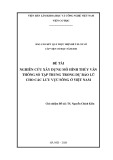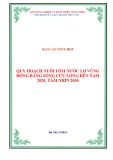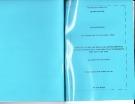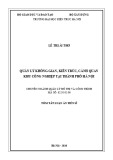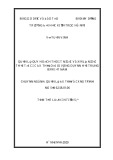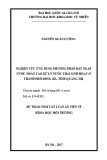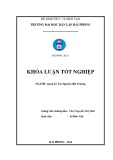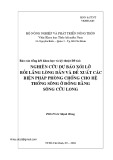
This Provisional PDF corresponds to the article as it appeared upon acceptance. Fully formatted
PDF and full text (HTML) versions will be made available soon.
Radio wave propagation in curved rectangular tunnels at 5.8 GHz for metro
applications, simulations and measurements
EURASIP Journal on Wireless Communications and Networking 2011,
2011:202 doi:10.1186/1687-1499-2011-202
Emilie Masson (emilie.masson@ifsttar.fr)
Yann Cocheril (yann.cocheril@ifsttar.fr)
Pierre Combeau (pierre.combeau@xlim.fr)
Lilian Aveneau (lilian.aveneau@xlim.fr)
Marion Berbineau (marion.berbineau@ifsttar.fr)
Rodolphe Vauzelle (vauzelle@sic.sp2mi.univ-poitiers.fr)
Etienne Fayt (etienne.fayt@transport.alstom.com)
ISSN 1687-1499
Article type Research
Submission date 19 July 2011
Acceptance date 15 December 2011
Publication date 15 December 2011
Article URL http://jwcn.eurasipjournals.com/content/2011/1/202
This peer-reviewed article was published immediately upon acceptance. It can be downloaded,
printed and distributed freely for any purposes (see copyright notice below).
For information about publishing your research in EURASIP WCN go to
http://jwcn.eurasipjournals.com/authors/instructions/
For information about other SpringerOpen publications go to
http://www.springeropen.com
EURASIP Journal on Wireless
Communications and
Networking
© 2011 Masson et al. ; licensee Springer.
This is an open access article distributed under the terms of the Creative Commons Attribution License (http://creativecommons.org/licenses/by/2.0),
which permits unrestricted use, distribution, and reproduction in any medium, provided the original work is properly cited.

1
Radio wave propagation in curved rectangular tunnels at 5.8 GHz for
metro applications, simulations and measurements
Emilie Masson*1, Yann Cocheril1, Pierre Combeau2, Lilian Aveneau2, Marion
Berbineau1, Rodolphe Vauzelle2, and Etienne Fayt3
1Université de Lille Nord de France, IFSTTAR, LEOST, F-59650 Villeneuve d'Ascq,
France
2XLIM-SIC Laboratory of the University of Poitiers, France
3ALSTOM-TIS (Transport Information Solution), F-93482 SAINT OUEN, Cedex,
France
*Corresponding author: emilie.masson@ifsttar.fr
Email addresses:
YC: yann.cocheril@ifsttar.fr
MB: marion.berbineau@ifsttar.fr
PC: pierre.combeau@xlim.fr
LA: lilian.aveneau@xlim.fr
RV: rodolphe.vauzelle@xlim.fr
EF: etienne.fayt@transport.alstom.com
Abstract
Nowadays, the need for wireless communication systems is increasing in
transport domain. These systems have to be operational in every type of
environment and particularly tunnels for metro applications. These ones can
have rectangular, circular or arch-shaped cross section. Furthermore, they

2
can be straight or curved. This article presents a new method to model the
radio wave propagation in straight tunnels with an arch-shaped cross section
and in curved tunnels with a rectangular cross section. The method is based
on a Ray Launching technique combining the computation of intersection
with curved surfaces, an original optimization of paths, a reception sphere,
an IMR technique and a last criterion of paths validity. Results obtained
with our method are confronted to results of literature in a straight arch-
shaped tunnel. Then, comparisons with measurements at 5.8 GHz are
performed in a curved rectangular tunnel. Finally, a statistical analysis of
fast fading is performed on these results.
Keywords: metro applications; wave propagation; ray launching; curved
tunnels; arch-shaped tunnels.
1. Introduction
Wireless communication systems are key solutions for metro applications to
carry, at the same time, with different priorities, data related to control-
command and train operation and exploitation. Driverless underground
systems are one of the best examples of the use of such wireless radio
system deployments based on WLAN, standards generally in the 2.45 or
5.8 GHz bands (New York, line 1 in Paris, Malaga, Marmaray, Singapore,
Shangaï, etc.). These systems require robustness, reliability and high

3
throughputs in order to answer at the same time the safety and the QoS
requirements for data transmission. They must verify key performance
indicators such as minimal electric field levels in the tunnels, targeted bit
error rates (BER), targeted handover times, etc. Consequently, metro
operators and industries need efficient radio engineering tools to model the
electromagnetic propagation in tunnels for radio planning and network
tuning. In this article, we propose an original method based on a Ray
Launching method to model the electromagnetic propagation at 5.8 GHz in
tunnels with curved cross section or curved main direction. The article is
organized as follows. Section 2 details existing studies on this topic.
Section 3 presents the developed method. A comparison of our results with
the ones obtained in the literature is performed in Section 4 for a straight
arch-shaped tunnel. Our method is then confronted to measurements at
5.8 GHz and validated in a curved rectangular tunnel in Section 5. A
statistical analysis of simulated results in a curved rectangular tunnel is then
performed in Section 6. Finally, Section 7 concludes the article and gives
some perspectives.
2. Existing studies on radio wave propagation in curved tunnels
Different approaches to model the radio wave propagation in tunnels were
presented in the literature. Analyses based on measurements represent the

4
first approach but such studies are long and expensive [1, 2]. Thus,
techniques based on the modal theory have been explored [3–5]. The modal
theory provides good results but is limited to canonical geometries since it
considers tunnels as oversized waveguides. Some authors have also
proposed an exact resolution of Maxwell’s equations based on numerical
techniques [6]. This kind of techniques is limited, specifically by the
computational burden due to the fine discretization requirement of the
environment, in terms of surface or volume. Finally, frequency asymptotic
techniques based on the ray concept, being able to treat complex geometries
in a reasonable computation time, seem to be a good solution. In [7], a
model based on a Ray Tracing provides the attenuation in a straight
rectangular tunnel. In [8], the author uses this method and adds diffraction
phenomenon in order to analyze coupling between indoor and outdoor. In
[9], studies are purchased by considering changes of tunnel sections. The
main drawback of the Ray Tracing method is the impossibility to handle
curved surfaces.
To treat curved surfaces, the first intuitive approach consists in a tessellation
of the curved geometry into multiple planar facets, as proposed in [10].
However, the surfaces’ curvature is not taken into account in this kind of
techniques and the impossibility to define rules for the choice of an optimal
number of facets versus the tunnel geometry and the operational frequency

![Mẫu Báo cáo tiến độ thực hiện đề tài [chuẩn nhất]](https://cdn.tailieu.vn/images/document/thumbnail/2025/20250318/tuongmotranh/135x160/1241742262566.jpg)
